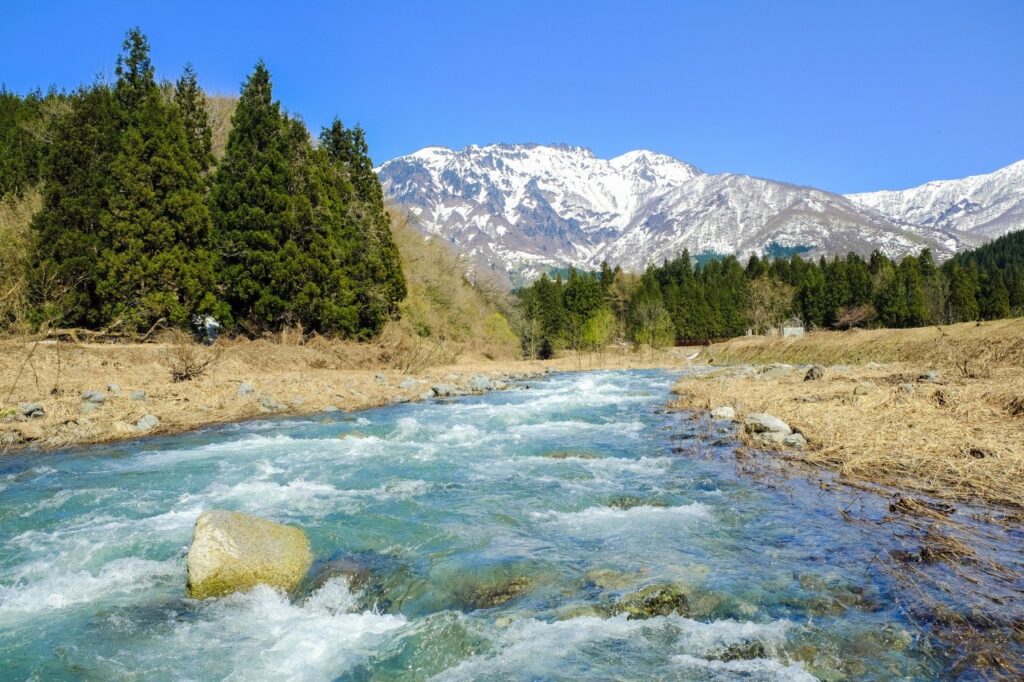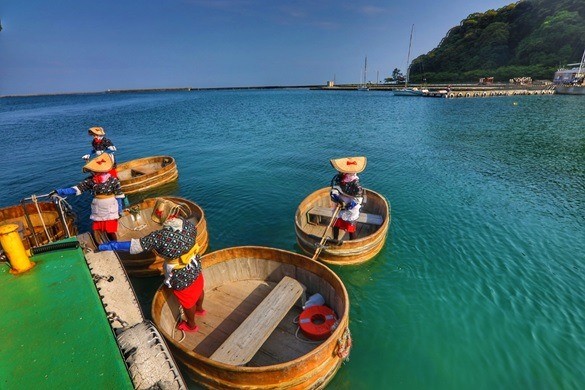Myokoukougen




With seven hot spring resorts including Myoko, Akakura, Ikenodaira, and Suginosawa, five different types of springs, and three different colors of hot water, the plateau is famous as a vacation home and ski resort.
After a cold and harsh winter, spring is full of joy, with beautiful flowers blooming here and there and a view of the mighty Nana Falls, whose waters have been swollen by melting snow. In summer, many areas are cooler than those on the plains, making it a perfect place to spend the hot summer months. Autumn is the best season for hiking in the mountains, including bird watching and trekking. In winter, the plentiful snowfall allows you to enjoy winter sports to the fullest.
Yahiko Shrine




Yahiko Shrine has been worshipped since ancient times and is said to have a history of over 2,400 years. 200,000 people visit this popular shrine every year for Hatsumode (New Year’s visit). The shrine grounds, covered with trees, have a sacred air, but it is also a popular spot for forest bathing and enjoying the autumn leaves. If you want to enjoy the solemn atmosphere, we recommend that you visit the shrine in the early morning when there are few people around. In the precincts of the temple, there is a “stone for divining wishes” called “Shigeki no Ishi” (stone of heavy weight). When you make a wish and lift the stone, if it feels light, your wish will be fulfilled; if it feels heavy, your wish will be difficult to fulfill.
Mt. Myoko




Myoko,” 2,454 meters high with abundant hot spring sources, is opened on July 1 every year and attracts many climbers from summer to autumn. The dynamic landscape of Mt. Myoko was selected as one of the 100 most famous mountains in Japan. The summit, which is a compound volcano and dotted with large rocks, offers a 360-degree view of Lake Nojiri and the lake below. Also known as “Mt. Shumisen,” meaning “high mountain rising in the center of the Buddhist world,” it is also called “Echigo Fuji.
Kiyotsukyo




Kiyotsukyo Gorge, known as one of Japan’s three great gorges along with Kurobe Gorge and Osugi Gorge, was designated as Joshinetsu Kogen National Park in September 1949, and is a treasure house of academic materials.
The huge rock walls that rise up across the river create a V-shaped grand canyon that is a national treasure, and is designated as a national natural monument of scenic beauty.
The combination of the majestic columnar-jointed rock surfaces and the clear rapids of the Kiyotsu River is dynamic and amazing, and leaves a deep impression on visitors.
Hakkaisan Ropeway




Hakkaisan, revered as a sacred mountain since ancient times, is a popular autumn color spot in Minamiuonuma City. It is one of the two hundred most famous mountains in Japan and is also known as one of the Echigo Sanzan (Three Mountains of Echigo) along with Echigo-Komagatake and Nakanodake.
A 5-minute cable car ride up the mountain through beautiful scenery brings you to the summit station. On a clear day, you can see the mountains of Joshinetsu, the Sea of Japan, and even Sado Island from here.
Spring, with its snow-covered green, summer, with its contrasting blue sky and green mountains, autumn, when the mountains are tinted with autumn leaves, and winter, with its pure white snowy landscapes, each of the four seasons has a different look that captivates visitors with its breathtaking beauty.
Maeina Falls




Naena Falls has been selected as one of the 100 best waterfalls in Japan. With a 55-meter drop, the waterfall is a powerful sight as it splashes down! It is also known as “Earthquake Falls” because the sound of water falling from the falls was so violent in the past that the roaring sound echoed through the surrounding forest, almost like an earthquake.
The most popular seasons to visit are spring, when a large amount of water from melting snow flows into the waterfall, and fall, when the surrounding scenery is beautifully colored and the leaves turn red. Summer is also recommended for its cooler temperatures.
Sado Island
It is the second largest island in Japan after Okinawa. This large island is packed with magnificent nature, leisurely island life, and interesting aspects that make it a miniature version of Japan. Sado Island has three major cultural characteristics: aristocratic culture, brought by aristocrats and intellectuals exiled in exile; samurai culture, brought from Edo by magistrates and government officials as a result of the development of mining; and merchant culture, brought by merchants and sailors on the Kitamae-bune, which have fused and nurtured these three cultures.
Sado Gold Mine Site




Sado Gold Mine is one of the largest gold and silver mines in Japan in modern times. The mine is said to have opened in 1596 and continued for nearly 400 years, with repeated ups and downs until it ceased operations in 1989. The mine shafts, mining sites, and industrial remains are designated as National Important Cultural Properties, Historic Sites, and Industrial Heritage of Modernization, and are also World Heritage candidates.
Tarai boat


One of Sado’s specialties is the “tarai-boat. It is said that the tarai-bune was invented around 1868, and that it is said to have been improved from a washing tub to the current tarai-bune. There is no need to worry about whether the boat will tip over or whether it will return. A female boatman boards the boat and skillfully maneuvers it. You can also row the boat.
Lombardy Trees




Shukunegi, located at the southernmost tip of Sado City, once prospered as a shipping village. The entire village was involved in the shipping business, including boat owners, sailors, ship carpenters, blacksmiths, and tub makers.
The streets of Shukunegi, where the skills of ship carpenters were combined, are a national Important Preservation District for Groups of Traditional Buildings. More than 100 houses with wooden walls and two stories are still clustered together in the maze of narrow, old-fashioned alleys. The exterior of the houses are covered with vertical wooden boards called “wrapped boards” to protect them from the sea breezes blowing from the Sea of Japan, but in contrast to the simple exterior, the interiors are luxurious, with abundant use of lacquer and other materials.
